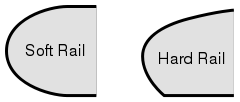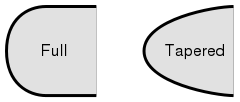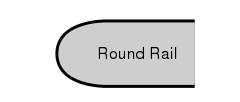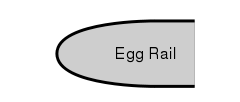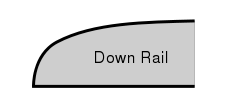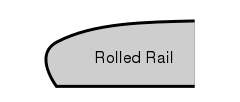Difference between revisions of "Rails"
| (6 intermediate revisions by the same user not shown) | |||
| Line 3: | Line 3: | ||
== Hard and Soft Rails == | == Hard and Soft Rails == | ||
Generally speaking, there are two types of rail design: soft and hard. Soft rails are rounded with no hard edges. The transition from the rail to the bottom of the board is very smooth. A hard rail (also called a down rail) is more squared off, sloping down in a more distinct manner and may form a corner or edge with the bottom. | Generally speaking, there are two types of rail design: soft and hard. Soft rails are rounded with no hard edges. The transition from the rail to the bottom of the board is very smooth. A hard rail (also called a ''down rail'') is more squared off, sloping down in a more distinct manner and may form a corner or edge with the bottom. | ||
[[File:Rail hardsoft.svg]] | [[File:Rail hardsoft.svg|border|Hard vs soft rails]] | ||
=== Hard Rails === | |||
Harder rails best suit the modern shortboard. They knife into the water's edge easier, making it plane faster and turn quicker. This is because the hard edge, especially in the tail, allows the water to abruptly release from the board's rails, creating more maneuverability and speed. If the surfer is so inclined to use his rails rather than rely heavily on the fins, it also allow for long drawn out rail turns. On the downside, hard rails with edges make pivotal turns more difficult. These rails are generally better in large, steep and hollow conditions. The hard edge allows the board to gain a firm hold in the wave and remain stable at faster speeds. The compromise is in rail volume. Even a shortboard must have thicker, softer rails in the center of the board if it is to float the surfer. The nose and tail volume will remain thinner and harder for speed and performance. | |||
=== | === Soft Rails === | ||
If hard rails are better suited for high performance shortboards, then softer rails are most common on longboards and small wave shortboards. Soft rails are more forgiving, meaning you are less likely to catch an edge and bog the rails into on sloppier wave face. The downside is they produce enormous drag and will not turn as easily on the rail in larger surf. In contrast, soft rails will allow a surfer to take full advantage of a fin's turning radius. Turning from near the tail should be much quicker and require less effort in smaller surf. Fuller, softer rails will help you paddle into more waves and also help you maintain speed in the flats of the wave. Although full rails are also more difficult to sink, this will translate into more stored energy during a turn and the release of that energy coming out of the turn (commonly known as drive). | If hard rails are better suited for high performance shortboards, then softer rails are most common on longboards and small wave shortboards. Soft rails are more forgiving, meaning you are less likely to catch an edge and bog the rails into on sloppier wave face. The downside is they produce enormous drag and will not turn as easily on the rail in larger surf. In contrast, soft rails will allow a surfer to take full advantage of a fin's turning radius. Turning from near the tail should be much quicker and require less effort in smaller surf. Fuller, softer rails will help you paddle into more waves and also help you maintain speed in the flats of the wave. Although full rails are also more difficult to sink, this will translate into more stored energy during a turn and the release of that energy coming out of the turn (commonly known as drive). | ||
=== Medium Rails === | === Medium Rails === | ||
== | Most surfers are better off with a medium rail. This should provide the advantages of both a hard and soft rail, while downplaying the negatives. A medium rail will produce a fast board in steep waves, while still allowing the freedom to use the fins creatively in surf that isn't so steep. The surfer should feel fairly stable with medium rails and be able to turn in a tight radius. The most common example is a "tucked under rail". This is a round rail with a tucked under edge that will provide some release, but also offers a smooth and forgiving ride. | ||
== Rail Volume == | |||
Each of these rail configurations (soft, hard) is then affected by the volume of the rail (if its tapered or full), and the height of the rail (where the apex of the rail is - 50/50, 60/40, 80/20 etc.). | |||
Volume: [[File:Rail full tapered.svg|border|Full vs tapered rails]] | |||
Height: [[File:Rail height.svg|border|Various rail heights]] | |||
50/50: A proportional description of a rail where the widest point of the rail is at the mid point of the rail. | |||
60/40: A proportional description of a rail where the widest point is towards the bottom. | |||
== Common Types of Rails == | |||
{| | {| | ||
| | | [[File:Rail round.svg]] | ||
| | | | ||
''' | '''Round rail:'''<br /> | ||
A well rounded rail that almost forms a complete semi-circle. | |||
|- | |- | ||
| | | [[File:Rail egg.svg]] | ||
| | | | ||
'''Egg rail''' | '''Egg rail:'''<br /> | ||
Similar to round rail but more drawn out (like an egg). | |||
|- | |- | ||
| | | [[File:Rail down.svg]] | ||
| | | | ||
''' | '''Down rail or down-turned rail:'''<br /> | ||
A rail coming to an edge at the bottom of the board. | |||
|- | |- | ||
| | | [[File:Rail rolled.svg]] | ||
| | | | ||
''' | '''Rolled rail:'''<br /> | ||
A down rail that is rolled under the board. | |||
|} | |} | ||
== Generalities about a Surfboard Rail == | == Generalities about a Surfboard Rail == | ||
* The lower | * The lower the rail height and volume, the less buoyant the surfboard will be. | ||
* The lower and harder a rail is, the faster it will be | * The lower and harder a rail is, the faster it will be, but won't be as maneuverable. | ||
* A hard rail provides better traction but will catch an edge easier then a soft rail. | * A hard rail provides better traction but will catch an edge easier then a soft rail. | ||
* Thinner, tapered rails are good for quick turns | * Thinner, tapered rails are good for quick turns. They sink easily, but are not able to carry speed coming out of a turn. | ||
* Fuller rails are harder to sink, which can translate into more drive coming out of turns. | * Fuller rails are harder to sink, which can translate into more drive coming out of turns. | ||
* High rails with lots of volume are more stable and will catch waves easier which is suited toward beginner surfers | * High rails with lots of volume are more stable and will catch waves easier, which is suited toward beginner surfers. However even experienced surfers will use higher railed surfboards for mushy, slow conditions. | ||
* The softer and rounder the rail, the slower and more neutral-handling | * The softer and rounder the rail, the slower and more neutral-handling it'll be. | ||
* | * Soft rails are generally found on longboards and small wave boards. | ||
* Hard rails | * Hard rails are generally found on high performance boards (short and long). | ||
== Bibliography == | == Bibliography == | ||
Latest revision as of 17:34, 25 October 2014
The rails are the "edge" of the surfboard and run from the tail to the nose of the board. Rails are where the deck and the bottom meet. Like the other parts of the surfboard, rails have their part to play in shaping the overall performance of the surfboard. The shape of the rails determines how water flows over them when the board is planing and turning. Different shapes have different uses. Rails are thickest towards the center of the board and thinnest at the tail and nose.
Hard and Soft Rails
Generally speaking, there are two types of rail design: soft and hard. Soft rails are rounded with no hard edges. The transition from the rail to the bottom of the board is very smooth. A hard rail (also called a down rail) is more squared off, sloping down in a more distinct manner and may form a corner or edge with the bottom.
Hard Rails
Harder rails best suit the modern shortboard. They knife into the water's edge easier, making it plane faster and turn quicker. This is because the hard edge, especially in the tail, allows the water to abruptly release from the board's rails, creating more maneuverability and speed. If the surfer is so inclined to use his rails rather than rely heavily on the fins, it also allow for long drawn out rail turns. On the downside, hard rails with edges make pivotal turns more difficult. These rails are generally better in large, steep and hollow conditions. The hard edge allows the board to gain a firm hold in the wave and remain stable at faster speeds. The compromise is in rail volume. Even a shortboard must have thicker, softer rails in the center of the board if it is to float the surfer. The nose and tail volume will remain thinner and harder for speed and performance.
Soft Rails
If hard rails are better suited for high performance shortboards, then softer rails are most common on longboards and small wave shortboards. Soft rails are more forgiving, meaning you are less likely to catch an edge and bog the rails into on sloppier wave face. The downside is they produce enormous drag and will not turn as easily on the rail in larger surf. In contrast, soft rails will allow a surfer to take full advantage of a fin's turning radius. Turning from near the tail should be much quicker and require less effort in smaller surf. Fuller, softer rails will help you paddle into more waves and also help you maintain speed in the flats of the wave. Although full rails are also more difficult to sink, this will translate into more stored energy during a turn and the release of that energy coming out of the turn (commonly known as drive).
Medium Rails
Most surfers are better off with a medium rail. This should provide the advantages of both a hard and soft rail, while downplaying the negatives. A medium rail will produce a fast board in steep waves, while still allowing the freedom to use the fins creatively in surf that isn't so steep. The surfer should feel fairly stable with medium rails and be able to turn in a tight radius. The most common example is a "tucked under rail". This is a round rail with a tucked under edge that will provide some release, but also offers a smooth and forgiving ride.
Rail Volume
Each of these rail configurations (soft, hard) is then affected by the volume of the rail (if its tapered or full), and the height of the rail (where the apex of the rail is - 50/50, 60/40, 80/20 etc.).
50/50: A proportional description of a rail where the widest point of the rail is at the mid point of the rail.
60/40: A proportional description of a rail where the widest point is towards the bottom.
Common Types of Rails
Generalities about a Surfboard Rail
- The lower the rail height and volume, the less buoyant the surfboard will be.
- The lower and harder a rail is, the faster it will be, but won't be as maneuverable.
- A hard rail provides better traction but will catch an edge easier then a soft rail.
- Thinner, tapered rails are good for quick turns. They sink easily, but are not able to carry speed coming out of a turn.
- Fuller rails are harder to sink, which can translate into more drive coming out of turns.
- High rails with lots of volume are more stable and will catch waves easier, which is suited toward beginner surfers. However even experienced surfers will use higher railed surfboards for mushy, slow conditions.
- The softer and rounder the rail, the slower and more neutral-handling it'll be.
- Soft rails are generally found on longboards and small wave boards.
- Hard rails are generally found on high performance boards (short and long).
